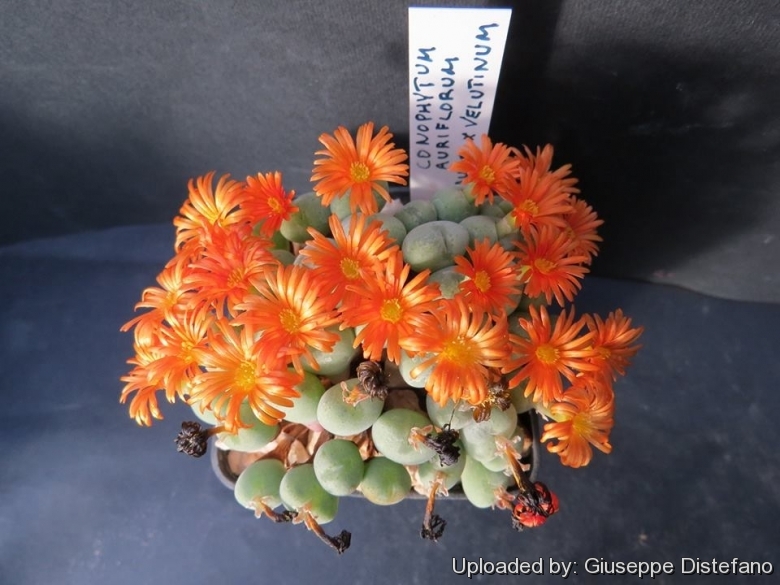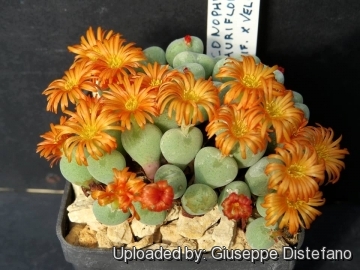
Conophytum hybrid auriflorum x velutinum Photo by: Giuseppe Distefano
Origin and Habitat: The origins of this plant is unknown exactly.
Synonyms:
Description: Conophytum hybrid auriflorum x velutinumSN|21975]]SN|29197]] is a small densely branched conophytum that forms low clumps or mats. It is distinguished by fiery orange flowers in autumn that set this species apart from other Conophytums. It could be a natural hybrid with Conophytum auriflorum (subsp. auriflorum) as one parent and Conophytum velutinumSN|29197]]SN|21975]] as the other. It's an old plant, that has been in cultivation for years. It has some horticultural merit and the plant is spectacular in full flower.
Stem: Stemless or with short stems with time.
Bodies (paired leaves): Barrel-shaped to long cylindrical or inversely conical with translucent fissure surrounded by a dark green band, apex convex, ca. 15 mm long and 6-9 mm wide. Epidermis rich green to reddish-green or brownish, glabrous, shining, unspotted or sparsely dotted, or or with a few wide translucent streaks.
The epidermis is smooth, but could be spotted near the fissure.
Flowers: Scentless up to 2 cm bright orange.
Blooming season: The flowers are autumnal (rarely in summer) and diurnal. While the small bright orange autumn flowers are already fully developed here, the new leaves are lurking inside the papery husks of their predecessors from last season. They still display the withered rest season look of the dry summer. The young leaves will swell out fully from inside them as the winter rain allows.
 Conophytum hybrid auriflorum x velutinum Photo by: Giuseppe Distefano
Conophytum hybrid auriflorum x velutinum Photo by: Giuseppe DistefanoSend a photo of this plant.The gallery now contains thousands of pictures, however it is possible to do even more. We are, of course, seeking photos of species not yet shown in the gallery but not only that, we are also looking for better pictures than those already present.
Read More... Cultivation and Propagation: Conophytum hybrid auriflorum x velutinumSN|29197]]SN|29197]] is a "winter" grower which is most active from late winter until later spring and heading for summer dormancy, but in favourable growing conditions it keeps going over the summer too and doesn't need particular care.
Soil: Requires good drainage as it it is prone to root rot. It can grows outdoor in sunny, dry, rock crevices (protection against winter wet is required) It can also be cultivated in alpine house, in poor, drained soil.
Watering: It requires little water; otherwise its epidermis breaks (resulting in unsightly scars). Water minimally in summer, (only when the plant starts shrivelling), but it will generally grow even in summer if given water. Water regularly in winter after the previous year's leaves have dried up. Requires good drainage.
Fertilization: Feed it once during the growing season with a fertilizer specifically formulated for cactus succulents (poor in nitrogen), including all micro nutrients and trace elements diluted to ½ the strength recommended on the label. It thrives in poor soils and need a limited supplies of fertilizer to avoid the plants developing excess vegetation, which is easily attacked by fungal diseases.
Exposure: Keep cool and shaded in summer, it needs full sun or light shade.
Temperature: Hardy to -2°C. Ensure a very good ventilation.
Repotting: Avoid to repot frequently. This plant may stay in the same pot for many years.
Uses: Container, rock garden.
Pests and diseases: It is vulnerable to mealybugs and rarely scale.
Propagation: It can be reproduced both by cuttings and seeds. Take the cutting from a grown-up mother plant. Each cutting must contain one or more heads along with a fraction of root. It is easily propagated by seed. The small seeds can be sown in pots of fine, well-drained sand, any time during the spring and summer months when temperatures are warm. Cover the seeds with a very fine layer of grit and water from below with a fungicide to prevent damping off. For the first 3-4 days cover the pots with a sheet of glass/clear perspex to keep the humidity levels high. Remove the glass and replace it with light shadecloth and mist once or twice a day for the next two weeks after which most seeds should have germinated. From then on mistings can be reduced to every second and then every third day as the little plants grow.












